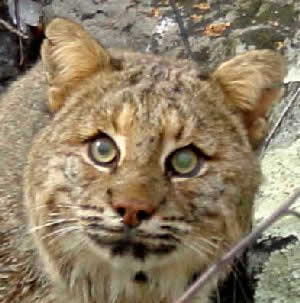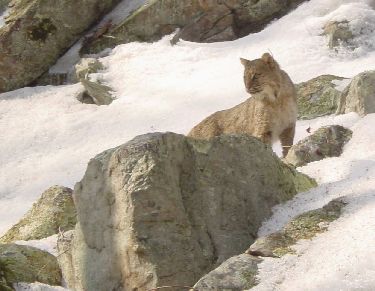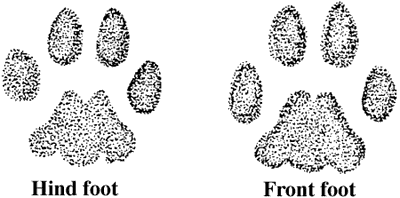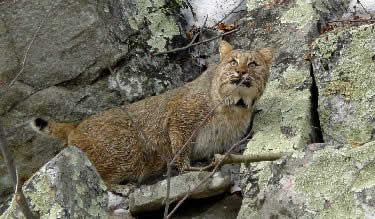Bobcat - March 2003 Species of the Month
The Bobcat (Felis refus) was the March Species
of the Month in honor of the 30th  Anniversary
of the New Jersey Endangered Species Conservation Act and the
formation of DEP's Endangered and Nongame Species
Program (ENSP). Anniversary
of the New Jersey Endangered Species Conservation Act and the
formation of DEP's Endangered and Nongame Species
Program (ENSP).
New Jersey's bobcat population first experienced declines
in the mid-1800s as forests were cleared for lumber, fuel, charcoal and agricultural
use. Between 1950 and 1970, reports of bobcat sightings and mortalities persisted,
but by the early 1970s they were thought to be extirpated (locally extinct)
from the State.
In 1972 the species gained legal protection when it was
classified as a game species with a closed season. Between 1978 and 1982 the
Division conducted a restoration project through which 24 bobcats were trapped
in Maine and released in northern NJ. In 1991 the bobcat was added to New Jersey's
list of endangered wildlife, where they remain.
Current management efforts involve the use of GPS transmitters that allow
biologists to monitor bobcat locations in order to determine habitat ranges
and preferences.

|
|
The Bobcat Challenge
- Bobcats use a wide variety of habitat types
and occupy large parcels of land relatively free from human
habitation and alteration.
- They also require suitable travel corridors
to allow for individuals to move between these parcels of land.
- Bobcats are found primarily in the northern
counties of Morris, Passaic, Sussex and Warren. Unconfirmed
reports have been received from eastern, central and southern
counties as well.
|
|
Bobcats - Facts of Interest
- Bobcats are feline carnivores and prefer
habitat that provides dense cover (undergrowth, conifers, thickets,
caves and ledges).
- The species gets its common name from its
stubby, or "bobbed", tail.
- They have tawny to gray-brown fur with spots
and streaks, and a whitish-colored underside. They are known for
having ruffs of fur on both sides of their face and small tufts
on their ears.
- Bobcats are active throughout the year and
do not hibernate - their peak periods of daily activity occur
around dawn and dusk.
|
|
|
| Ways
You Can Help |
|
Report all bobcat sightings to the NJ Division of
Fish and Wildlife's Endangered and Nongame Species Program by calling
908-735-8975.
Check-off for Wildlife when completing your
state tax return each year! This is a primary funding source for the preservation
of the State's endangered and nongame wildlife.
|
 |
|
|
Order a
Conserve Wildlife special interest license plate for your vehicle. It's
tax-deductible, with 80 percent of the payment benefiting New Jersey's Endangered
and Nongame Species Program. |
|
Want to volunteer? Enjoy giving presentations? Looking
for speakers? The Division of Fish and Wildlife offers two opportunities:The
Endangered and Nongame Species Program's Speakers
Bureau and the Division's Wildlife Conservation
Corps. Visit these sites for details.
|
|
|
| Additional Sources of Information |
|
|
 |
|
 Anniversary
of the New Jersey Endangered Species Conservation Act and the
formation of DEP's Endangered and Nongame Species
Program (ENSP).
Anniversary
of the New Jersey Endangered Species Conservation Act and the
formation of DEP's Endangered and Nongame Species
Program (ENSP).





